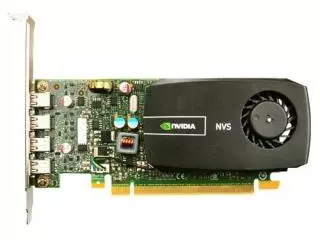GeForce 920A vs NVS 510
In this comparison between GeForce 920A and NVS 510 you will find out which graphics card performs better in today's games. Bear in mind that third-party versions may have more efficient cooling and higher clock speeds. This will increase cards' performance, though not by much. In addition to raw power you should also take into account the dimensions. Thicker models simply will not fit into a small mini-ITX case. The resolution of your monitor also affects the choice, since 4K gameplay requires a more powerful GPU. And don't overspend on the graphics card. Other parts of your build may also need to be upgraded, save some money for the CPU or power supply. For some people GeForce 920A will be the best choice, for others NVS 510 will be their preference. Study the comparison tables below and make your choice.
GeForce 920A
Main Specs
GeForce 920A
NVS 510
Power consumption (TDP)
33 Watt
35 Watt
Interface
PCIe 3.0 x8
PCIe 2.0 x16
Supplementary power connectors
None
Memory type
DDR3
DDR3
Maximum RAM amount
2 GB
2 GB
Display Connectors
No outputs
4x mini-DisplayPort
Check Price
NVS 510 has 6% more power consumption, than GeForce 920A.
GeForce 920A is connected by PCIe 3.0 x8, and NVS 510 uses PCIe 2.0 x16 interface.
GeForce 920A and NVS 510 have maximum RAM of 2 GB.
Both cards are used in Desktops.
GeForce 920A is build with Kepler 2.0 architecture, and NVS 510 - with Kepler.
Core clock speed of GeForce 920A is 157 MHz higher, than NVS 510.
GeForce 920A and NVS 510 are manufactured by 28 nm process technology.
Memory clock speed of GeForce 920A is 220 MHz higher, than NVS 510.
Game benchmarks
Assassin's Creed Odyssey
Battlefield 5
Call of Duty: Warzone
Counter-Strike: Global Offensive
Cyberpunk 2077
Dota 2
Far Cry 5
Fortnite
Forza Horizon 4
Grand Theft Auto V
Metro Exodus
Minecraft
PLAYERUNKNOWN'S BATTLEGROUNDS
Red Dead Redemption 2
The Witcher 3: Wild Hunt
World of Tanks
high / 1080p
0−1
0−1
QHD / 1440p
0−1
0−1
low / 720p
1−2
1−2
medium / 1080p
0−1
0−1
GeForce 920A and NVS 510 have the same average FPS in Assassin's Creed Odyssey.
QHD / 1440p
0−1
0−1
low / 720p
0−1
0−1
low / 768p
50−55
50−55
high / 1080p
45−50
45−50
QHD / 1440p
0−1
0−1
GeForce 920A and NVS 510 have the same average FPS in Call of Duty: Warzone.
low / 768p
60−65
60−65
medium / 768p
27−30
27−30
ultra / 1080p
7−8
7−8
high / 768p
16−18
16−18
GeForce 920A and NVS 510 have the same average FPS in Counter-Strike: Global Offensive.
low / 768p
70−75
70−75
ultra / 1080p
0−1
0−1
medium / 1080p
45−50
45−50
GeForce 920A and NVS 510 have the same average FPS in Cyberpunk 2077.
low / 768p
45−50
45−50
medium / 768p
10−11
10−11
ultra / 1080p
0−1
0−1
GeForce 920A and NVS 510 have the same average FPS in Dota 2.
low / 720p
0−1
0−1
low / 720p
21−24
21−24
medium / 1080p
0−1
0−1
GeForce 920A and NVS 510 have the same average FPS in Fortnite.
high / 1080p
0−1
0−1
QHD / 1440p
0−1
0−1
low / 720p
0−1
0−1
medium / 1080p
0−1
0−1
low / 768p
18−20
18−20
high / 1080p
0−1
0−1
QHD / 1440p
0−1
0−1
medium / 720p
12−14
12−14
GeForce 920A and NVS 510 have the same average FPS in Grand Theft Auto V.
low / 720p
0−1
0−1
low / 768p
75−80
75−80
high / 1080p
27−30
27−30
GeForce 920A and NVS 510 have the same average FPS in Minecraft.
low / 720p
8−9
8−9
GeForce 920A and NVS 510 have the same average FPS in PLAYERUNKNOWN'S BATTLEGROUNDS.
low / 720p
0−1
0−1
low / 768p
0−1
0−1
low / 768p
45−50
45−50
medium / 768p
14−16
14−16
ultra / 1080p
0−1
0−1
high / 768p
12−14
12−14
GeForce 920A and NVS 510 have the same average FPS in World of Tanks.
Full Specs
GeForce 920A
NVS 510
Architecture
Kepler 2.0
Kepler
Code name
GK208B
GK107
Type
Desktop
Workstation
Release date
13 March 2015
23 October 2012
Pipelines
384
192
Core clock speed
954 MHz
797 MHz
Transistor count
915 million
1,270 million
Manufacturing process technology
28 nm
28 nm
Texture fill rate
30.53
12.75
Floating-point performance
441.6 gflops
306.0 gflops
Length
160 mm
Memory bus width
64 Bit
128 Bit
Memory clock speed
2002 MHz
1782 MHz
Memory bandwidth
16.02 GB/s
28.51 GB/s
DirectX
12 (11_0)
12 (11_0)
Shader Model
5.1
5.1
OpenGL
4.6
4.6
OpenCL
1.2
1.2
Vulkan
1.1.126
1.1.126
CUDA
3.5
3.0
Bitcoin / BTC (SHA256)
17 Mh/s
Check Price


